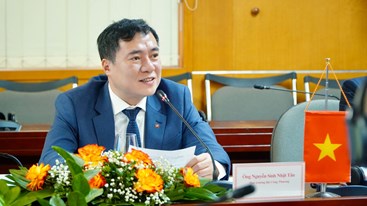Friday, 03/05/2024 | 08:32 GMT+7
The resources of traditional energy in Hai Phong are depleted by fast economic development and high demand of energy. Therefore, not only the efficient and economical use of traditional energy but also the adaptation of renewable energy should be promoted for a sustainably economic development and environmental conservation.

Solar panels in Dau island, Do Son district
In the conference “Application of Renewable Energy Technology to People's Lives” held by Hai Phong Technology Exchange, Mr. Pham Van Duy, deputy manager of Vietnam New And Renewable Energy Center said that there are about 2,000-2,500 sunny hours in Vietnam each year, the average shining rate is about 150kCal/cm2, equal to 43.9 million tons of oil per year. Onshore wind power resource is very potential and can generate approximately 800-1,400 KWh/m2/year. Moreover, biomass generated is equal to 43-46 million TOEs, 60% from wood wastes and 4% from agricultural wastes.
The Red river delta, where wind power and solar energy resources are limited, still possesses the impressive potential of geothermal energy. According to a team of researchers from Geographical Institute (Vietnam Academy of Science and Technology), geothermal energy resources are excellent, including geothermal energy in Southeast-Northwest sedimentary basins with up to 160 degree Celsius at the 4-kilometre depth (account for 16% of Vietnam general capacity in 2006), in rupture zones of Lo river-Vinh Ninh with about 114 degree Celsius and geothermal water sources varying from 40 to 50 degree in Haiphong, Hanoi, Hai Duong, etc.
According to Mr. Nguyen Hoai Lam, deputy manager of Haiphong Science and Technology Progress Adaption Center, Hai Phong has the potential of solar power, wind energy, biomass and geothermal energy. Therefore, resolutions, advanced programmes for improving capacity in manufacture and consuming have been implemented to lower the amount of greenhouse gas emissions and promote the use of renewable energy. At the same time, Hai Phong People’s Committees has deployed resolutions about science and technology development, which clearly emphasize the use of renewable energies such as solar, wind and wave power in manufacture, commercial and daily lives’ activities.
From the perspective of Dr. Ngo Tuan Kiet of Vietnam Institute of Energy Technology, with the plentiful resources of renewable energy, Hai Phong can utilize solar photovoltaics, wind power, biomass and heat pumps technologies. For example, heat pumps can be applied in households, and enterprises through the operation of pumping heat from lower to higher temperature. It can supply cooling source for air-conditioner systems, warm water for demands of sanitation, laundry, drying agricultural products and producing clean ice.
Apart from heat pumps, Haiphong can use the source of biomass from woods, by-products- wastes from plants, animal, and other organic wastes. Take biogas tunnel as an example for biomass technology application. It both meets the demand of household heating and protects living environment. The cost of building a biogas tunnel is low but its efficiency lasts long, which is suitable for people, especially in rural areas.
In the past, the renewable energy was not utilized because of some shortage in policy deployment and technology. However, in the upcoming time, in an attempt not to waste the benefit from existing renewable energy, Hai Phong authority will make a clear plan from investing and developing renewable energy technologies to encouraging the use of renewables in residential and manufacturing activities towards energy efficiency, environmental protection and a clean, green and sustainable economy.
Yen Le


.png?w=367&h=206&mode=crop)





.jpg?w=367&h=206&mode=crop) Energy efficiency and conservation usage is an important aspect of the national energy development strategy
05/03/2024
Energy efficiency and conservation usage is an important aspect of the national energy development strategy
05/03/2024
 Challenges and Opportunities to promote energy efficiency market in Vietnam
Challenges and Opportunities to promote energy efficiency market in Vietnam
 The Ministry of Industry and Trade requests government agencies to coordinate in organizing Earth Hour 2024
The Ministry of Industry and Trade requests government agencies to coordinate in organizing Earth Hour 2024
 Consultation on Energy Efficiency Boiler Catalogue and Wood Drying Guideline
Consultation on Energy Efficiency Boiler Catalogue and Wood Drying Guideline
 Son Ha Co., Ltd, applies energy efficiency and conservation measures
Son Ha Co., Ltd, applies energy efficiency and conservation measures
.png?w=367&h=206&mode=crop) Request for expression of interest - C2.1.13: Capacity Building on energy efficiency policies development
Request for expression of interest - C2.1.13: Capacity Building on energy efficiency policies development
 Phuc Kien Co., Ltd., is effectively implementing energy-saving measures
Phuc Kien Co., Ltd., is effectively implementing energy-saving measures
 Request for expression of interest - C2.1.12: Independent monitoring of safeguards implementation
Request for expression of interest - C2.1.12: Independent monitoring of safeguards implementation